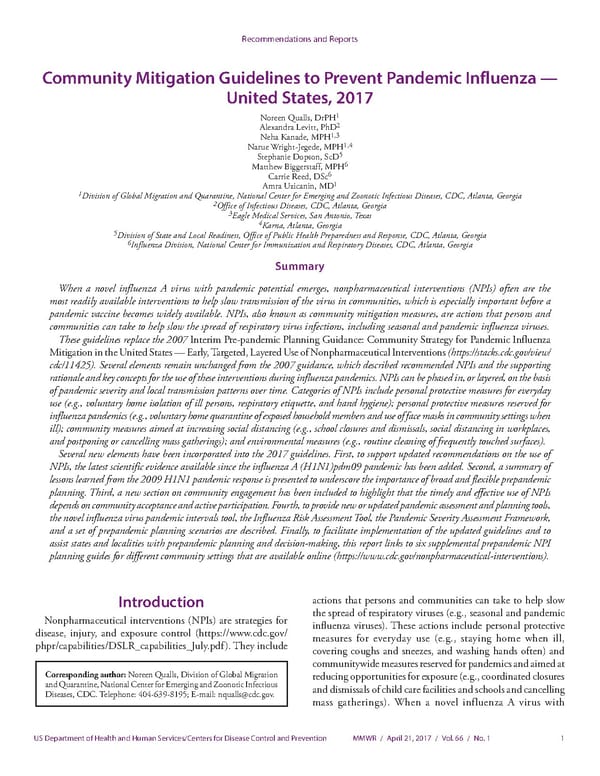Recommendations and Reports Community Mitigation Guidelines to Prevent Pandemic Influenza — United States, 2017 1 Noreen Qualls, DrPH 2 Alexandra Levitt, PhD 1,3 Neha Kanade, MPH Narue Wright-Jegede, MPH1,4 Stephanie Dopson, ScD5 6 MatthewBiggerstaff, MPH Carrie Reed, DSc6 Amra Uzicanin, MD1 1Division of Global Migration and Quarantine, National Center for Emerging and Zoonotic Infectious Diseases, CDC, Atlanta, Georgia 2Office of Infectious Diseases, CDC, Atlanta, Georgia 3Eagle Medical Services, San Antonio, Texas 4 Karna, Atlanta, Georgia 5Division of State and Local Readiness, Office of Public Health Preparedness and Response, CDC, Atlanta, Georgia 6Influenza Division, National Center for Immunization and Respiratory Diseases, CDC, Atlanta, Georgia Summary When a novel influenza A virus with pandemic potential emerges, nonpharmaceutical interventions (NPIs) often are the most readily available interventions to help slow transmission of the virus in communities, which is especially important before a pandemic vaccine becomes widely available. NPIs, also known as community mitigation measures, are actions that persons and communities can take to help slow the spread of respiratory virus infections, including seasonal and pandemic influenza viruses. These guidelines replace the 2007 Interim Pre-pandemic Planning Guidance: Community Strategy for Pandemic Influenza Mitigation in the United States — Early, Targeted, Layered Use of Nonpharmaceutical Interventions (https://stacks.cdc.gov/view/ cdc/11425). Several elements remain unchanged from the 2007 guidance, which described recommended NPIs and the supporting rationale and key concepts for the use of these interventions during influenza pandemics. NPIs can be phased in, or layered, on the basis of pandemic severity and local transmission patterns over time. Categories of NPIs include personal protective measures for everyday use (e.g., voluntary home isolation of ill persons, respiratory etiquette, and hand hygiene); personal protective measures reserved for influenza pandemics (e.g., voluntary home quarantine of exposed household members and use of face masks in community settings when ill); community measures aimed at increasing social distancing (e.g., school closures and dismissals, social distancing in workplaces, and postponing or cancelling mass gatherings); and environmental measures (e.g., routine cleaning of frequently touched surfaces). Several new elements have been incorporated into the 2017 guidelines. First, to support updated recommendations on the use of NPIs, the latest scientific evidence available since the influenza A (H1N1)pdm09 pandemic has been added. Second, a summary of lessons learned from the 2009 H1N1 pandemic response is presented to underscore the importance of broad and flexible prepandemic planning. Third, a new section on community engagement has been included to highlight that the timely and effective use of NPIs depends on community acceptance and active participation. Fourth, to provide new or updated pandemic assessment and planning tools, the novel influenza virus pandemic intervals tool, the Influenza Risk Assessment Tool, the Pandemic Severity Assessment Framework, and a set of prepandemic planning scenarios are described. Finally, to facilitate implementation of the updated guidelines and to assist states and localities with prepandemic planning and decision-making, this report links to six supplemental prepandemic NPI planning guides for different community settings that are available online (https://www.cdc.gov/nonpharmaceutical-interventions). Introduction actions that persons and communities can take to help slow Nonpharmaceutical interventions (NPIs) are strategies for the spread of respiratory viruses (e.g., seasonal and pandemic disease, injury, and exposure control (https://www.cdc.gov/ influenza viruses). These actions include personal protective phpr/capabilities/DSLR_capabilities_July.pdf). They include measures for everyday use (e.g., staying home when ill, covering coughs and sneezes, and washing hands often) and communitywide measures reserved for pandemics and aimed at Corresponding author: Noreen Qualls, Division of Global Migration reducing opportunities for exposure (e.g., coordinated closures and Quarantine, National Center for Emerging and Zoonotic Infectious and dismissals of child care facilities and schools and cancelling Diseases, CDC. Telephone: 404-639-8195; E-mail: [email protected]. mass gatherings). When a novel influenza A virus with US Department of Health and Human Services/Centers for Disease Control and Prevention MMWR / April 21, 2017 / Vol. 66 / No. 1 1
 Community Mitigation Guidelines to Prevent Pandemic Influenza Page 2 Page 4
Community Mitigation Guidelines to Prevent Pandemic Influenza Page 2 Page 4